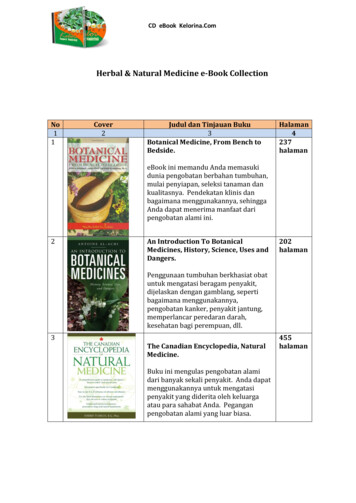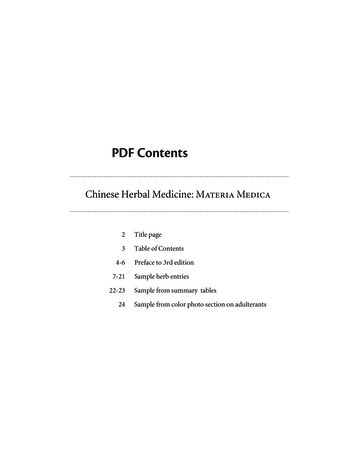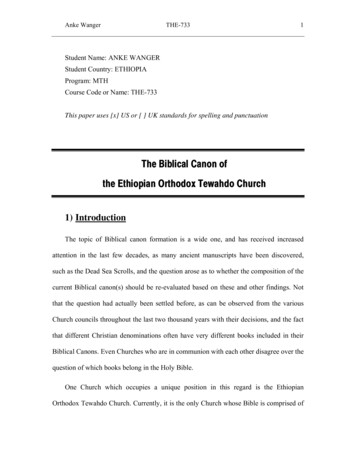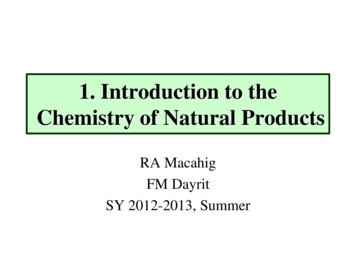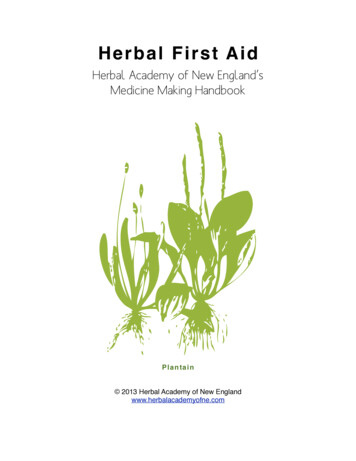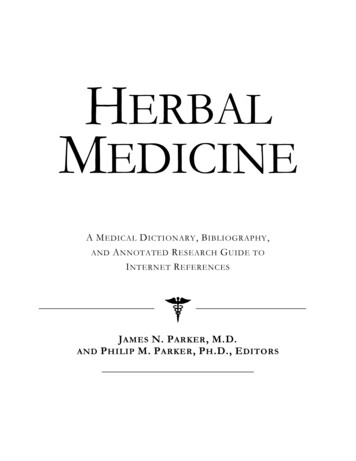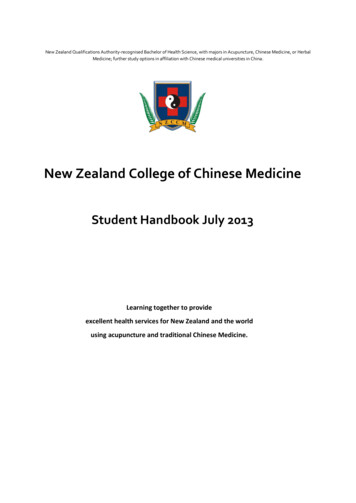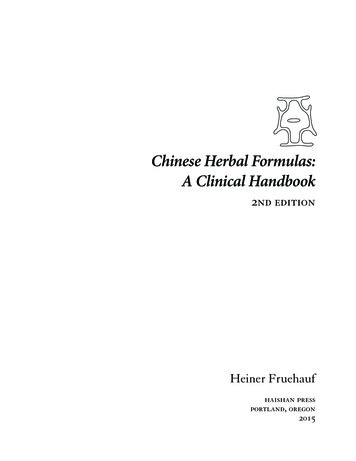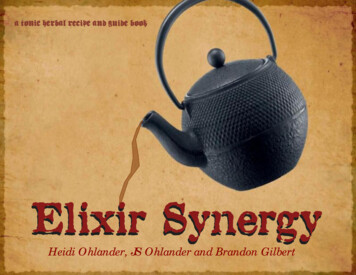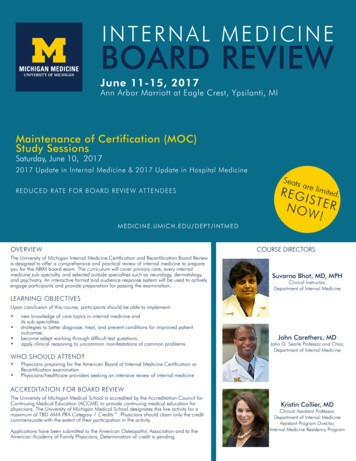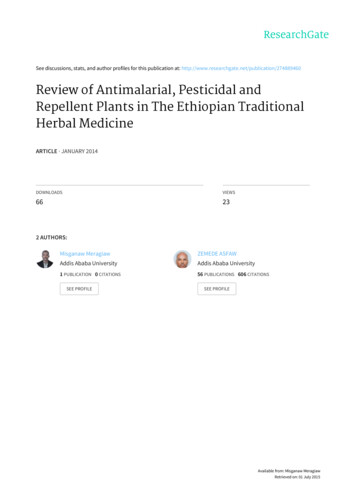
Transcription
See discussions, stats, and author profiles for this publication at: eview of Antimalarial, Pesticidal andRepellent Plants in The Ethiopian TraditionalHerbal MedicineARTICLE · JANUARY 2014DOWNLOADSVIEWS66232 AUTHORS:Misganaw MeragiawZEMEDE ASFAWAddis Ababa UniversityAddis Ababa University1 PUBLICATION 0 CITATIONS56 PUBLICATIONS 606 CITATIONSSEE PROFILESEE PROFILEAvailable from: Misganaw MeragiawRetrieved on: 01 July 2015
Research & Reviews: Journal of Herbal ScienceISSN: 2278-2257 (online), ISSN: 2348-9553 (print)Volume 3, Issue 3www.stmjournals.comReview of Antimalarial, Pesticidal and Repellent Plants inThe Ethiopian Traditional Herbal MedicineMisganaw Meragiaw*, Zemede AsfawDepartment of Plant Biology & Biodiversity Management, College of Natural Sciences,P.O.Box 1176, Addis Ababa University, Addis Ababa, EthiopiaAbstractA bibliographic survey of information available in various sources was undertaken and arich assamblege of plants used as antimalarials, insecticidals and repellents in theEthiopian traditional herbal medicine system was compiled. Those plant species weretabulated in Excel spreadsheet and descriptive statistics applied for analysis of the data.A total of 177 plant species belonging to 148 genera and 65 families were documented.Shrubs (40.1%) and herbs (39.5%) accounted for higher proportions (80%) of the totalspecies. The uses of leaves (61 spp.) and roots (29 spp.) claimed higher frequencies thanother parts. The species were recorded from a wide range of altitudes with 38.5% comingfrom below 2400 m, areas generally known for being malarious. Most of these specieswere said to be used in connection with malaria and nuisance arthropods. The findingscould assist research in phytochemistry, pharmacology, biomedicine, conservation andrelated works on top of documenting the biocultural heritage of the various Ethiopianethno-linguistic communities. This compilation would also be beneficial to the healthcareservices as it provides valuable ethnobotanical leads to plants with useful medicinalproperties for possible drug discovery. The findings notify that there is a rich tradition ofusing plants especially for the treatment and prevention of malaria. The findings send aclear signal about the fragility of the associated indigenous knowledge/skills of the localcommunities in the face of escalating anthropogenic and natural pressures. The wayforward calls for in situ conservation and putting the indigenous knowledge in to practicein order to mitigate the impeding problems facing the plants as well as the knowledge.Keywords: antimalarials, insecticides, mosquitocides, pesticides, repellents*Author for Correspondence E-mail: misganme@gmail.comINTRODUCTIONBackgroundMalaria control still remains to be an urgentmatter in countries where the disease isrampant. Ethiopia is among such countriesexperiencing the malaria epidemic, which is aleading public health problem even thoughvarious control methods are being mounted[1]. Strategies adopted by local communitiesto combat malaria, as in many other countries,largely rely on plant-based prevention andtreatment methods founded on theirindigenous botanical and traditional herbalmedical knowledge.Over the years, some researchers focusedattention to gathering of information both onthe traditional medicinal plants associated withthe control of malaria and the indigenousmedical lore as practiced by local communities[2, 3] while other researchers concentrated onplants for the control and eradication ofvarious pests affecting humans and theirlivestocks. The bulk of the reportedethnobotanical information, however, isscattered in various published and unpublishedvolumes and databases.We belived that a bibliographic compilation ofsuch scattered information would be a goodservice to researchers who are interested inextraction and testing of plant products fortheir antimalrial actions, insecticidal propertiesand repellent activities. This in turn could beeffectively used in the efforts to controlmalaria, mosquito bites and to handle ticks,harmful farmland insects and other householdarthropods such as fleas, lice and bedbugs.RRJoHS (2014) 21-45 STM Journals 2014. All Rights ReservedPage 21
Antimalarial, Insecticidal and Repellent Plants in EthiopiaSuch a list would be a good starting point formany researchers and graduate students. Thisdrive was further fueled by our observation ofincreasing ethnobotanical research resultsfurnishing records of candidate medicinalplants available in various volumes and textsinspite of which there is no comprehensive listthat could be used as a quick reference forresearchers. The growing number ofresearchers involved in malaria both in thepharmaceutical and biological areas will beserved by the outcome. The data can also beused as a basis for developing managementplans for conservation and sustainable use ofthese medicinal plants [4, 5].The General Ecology and Epidemiology ofMalariaMore than two billion people, mostly intropical countries, are at risk from mosquitoborne diseases such as malaria, dengue,hemorrhagic fever and filariasis [6]. Malariacauses an estimated 310-515 million clinicalepisodes (cases) with 1.5-3.0 million deathsper year, mostly children worldwide and subSaharan Africa shares 80% of the cases and90% of deaths [6–9]. Likewise, malaria is aleading communicable disease seen at healthfacilities in Ethiopia where 68% (57.3 million)of inhabitants are estimated to be at risk ofmalaria and the problem is compounded byincreasing frequency and magnitude of malariaepidemics [1].Physical and climatic conditions arefavourable to malaria transmission, typicallythe breeding of mosquito carriers, is verytemperature-sensitive [10]. Altitude issignificant in determining the distribution ofmalaria and its seasonal impact on manyregions of the world. In Africa, for example,altitudes above 1,000-1,500 m are consideredsafe from malaria. However, it must becautioned that with continuing global climatechange, these figures may change, extendingthe range of mosquitoes well above thosealtitudes as ambient temperatures rise [8, 11–13]. Ethiopia is characterized by seasonal,largely unstable and intense malariatransmission. The major transmission ofmalaria follows the June-September rains andoccurs between September-December. Themajor transmission season occurs in almostevery part of the country. There are five majorMeragiaw and Asfaweco-epidemiological strata of malaria in thecountry [9] cited in MoH (2007): Malaria free highland areas above2,500 meters altitude; Highlandborderareasbetween1,500-2,500 meters (affected by frequentepidemics); Lowland areas below 1,500 meters (withseasonal pattern of transmission); Arid areas where malaria is only foundnear semi-permanent water bodies; and Stable malaria areas (characterized by allyear round transmission) in the westernlowlands and river basin areas ofGambellaandBenishangul-GumuzRegional States.Knowledge on local malaria situations is thusan important step in planning scientific studyand control activities since the transmissiondynamics and determinants differ in time andspace.Causes of Parasites and Transmissionof MalariaPlasmodium falciparum is by far the mostaggressive species, distributed globallyespecially common in Africa [7, 13, 14]. P.falciparum and P. vivax are the most dominantmalaria parasites in Ethiopia, distributed allover the country and accounting for 60 and40% of malaria cases respectively. P. malariaeaccounts for less than 1% and P. ovale israrely reported. The parasite is principallytransmitted from person to person by the majormosquito vector known as Anophelesarabiensis, which bites only at night [9]. Insome areas A.pharoensis, A. funestus andA.nili also transmit the disease [7, 14].Factors Influencing Malaria ControlIn addition to many factors that include rapidenvironmental and biological changes, theburden of malaria has also been increasing dueto increasing anti-malaria drugs andinsecticide resistance, and complex socialstructures [8, 12, 15]. Consequently, there isno single method of malaria control that iscompletely effective in high transmission areas[16]. Even the most widely testedinterventions, using bed nets treated withpyrethroid insecticides, have proven difficultto implement correctly because of problemsrelated to equity, accessibility, userRRJoHS (2014) 21-45 STM Journals 2014. All Rights ReservedPage 22
Research & Reviews: Journal of Herbal ScienceVolume 3, Issue 3ISSN: 2278-2257 (online), ISSN: 2348-9553 (print)compliance and insecticide resistance [17, 18].The management of the disease with modernmedicines is severely weakened by awidespread presence of P. falciparum strainsresistant to the most affordable drugs, likechloroquine, mefloquine, and sulfadoxine [19].The other challenge in effective modernmedicines like Coartem, the treatment is alsotoo expensive for wider use in resource poorcountries like Ethiopia [20]. Other concernsincluded fear associated with possible healthhazards and negative environmental impacts ofthe insecticides [18]. In Ethiopia, efforts tocombat the disease are also constrained byshortage of trained human resource, drugs,laboratory supplies and field logistics [9, 17].Traditional Herbal Medicine in ControllingMalariaMalaria control receives much attention inmodern research [8, 18] including throughdrug discovery and application. Modernhealthcare focused on malaria in Ethiopiastarted as a pilot project in the 1950s andscaled up as a national malaria eradicationcampaign in the 1960s, followed by a controlstrategy in the 1970s. These efforts haveremained inadequate given the magnitude ofthe problem. The traditional medicine side ofmalaria control, which continued sinceimmemorial times, relied on the rich plantresources that notably feature in the local floraand indigenous medical lore [21]. Traditionalmedicinal plants are nature’s gifts developedby indigenous people in their prolongedstruggle with diseases affecting humans andlivestock and this continues to the present [2,3, 14, 22, 23]. These plants are sources ofenvironmentally friendly and biodegradablenatural products as an alternative greenmeasure of control [8, 15, 24]. Cognizant ofthe key roles of such medicinal plants,biologists, pharmacists and medical scientistshave sharply focused research attention onthem. Ethnobotanical surveys among localcommunities in particular accompanied withextractions and testing of promising plantspecies have started yielding potentially goodcompounds. Insecticides, insect repellents andphytomedicines of plant origin have been usedfor a long time and are traditionally tested tobe suitable for safe use in the control ofmalaria and its vectors [19, 25–28].Thesciencesofethnobotanyandethnomedicine are developing rapidly due tothe integration of traditional medicine withmodern healthcare services. This is importantto standardize and develop plant extracts intovarious dosage forms with an effective drug atan affordable cost [12, 29, 30]. However, towhat extent such endeavours will be fruitfuland impact on malaria burden in the future, isbasically depending on the capacity of bothmodern scientists and traditional medicinepractitioners in trusting and respecting eachother. The objective of this study was tocompile ethnobotanical information uito/insect repellents and other vectorborn diseases combating traditional medicinalplants of Ethiopia used by local communities.MATERIALS AND /insecticidal, and mosquito/insect repellent plants were collected fromdocuments (published or grey literature)available in various forms: books, publishedarticles, theses, research reports, herbariumdatabases and other written sources. Differentethnobotanical publications by staff andgraduate students over the past couple ofdecades, the relevant ethnobotanical MSc andPhD theses as well as other botanical sourceswere reviewed. Various on-line sourcesincluding Google Scholar were browsed usingsome important key words. The scientificnames were checked and confirmed withvolumes of the Flora of Ethiopia and Eritrea[1–8]. For each plant species, medicinal useinformation were gathered in details to includethe antimalarials, pesticides (mosquitocide,insecticide), repellents (mosquito, insect) andrepellents of other arthropods. Appropriatedata collection format was prepared to tabulatescientific, family and local names of speciesalong with; plant habit, altitude of collection,floristic region and site (district, locality) ofcollection and the sources of references eachspecies. The information was entered in Excelspread. The collected data were analyzed usingdescriptive statistics to evaluate the percentageand frequency of different aspects such as,categories of medicinal plants, growth forms,altitudinal ranges, method of preparation andRRJoHS (2014) 21-45 STM Journals 2014. All Rights ReservedPage 23
Antimalarial, Insecticidal and Repellent Plants in Ethiopiaplant parts used. The results were presentedwith graphs, charts and tables.RESULTS AND DISCUSSIONThe various surveys carried out in Ethiopiahave allowed the description of a large numberof plants used by the indigenous people totreat different diseases, and malaria is onedisease for which a considerable number ofspecies were listed especially in the endemicareas of its prevalence. This is quite largerthan that of researchers in Nigeria [8], reported101 species used in connection with malaria intheir review.Taxonomic Diversity of Antimalarials,Mosquitoecides/Insecticides, andMosquito/Insect RepellentsIn the present survey, a total of 177 plantspecies which belong to 148 genera and 65families were compiled. Of these, 96antimalarial plant species, 25 repellents(mosquito/insect) and 13 pesticidal specieswere documented (Table 2). The recentpractice of treating repellent plants with plantsused as insecticides is not considered sound.Thus, in this study, we treated them separatelyeventhough there may be some overlaps.Table 1: Number of Species and Type ofWritten Sources Reviewed.Number ofSpeciesSum of DifferentReference% ofFrequencyMSc theses9416693.8Journal 218.1Total265362204.6 Table 2: Taxonomic Diversity of Antimalarial,Pesticidal (Mosquitoecides/Insecticides) andRepellents (Mosquito/Insect) in Ethiopia.Category of Plants UsedNumber of Plant Species in VariousReviewed SourcesAmong the many materials we reviewed, therewere 33 sources of which 24 were masters’theses, 10 were journal articles, 4 were booksand 1 was database. Different sources gavedifferent number of species used in connectionwith malaria. Names of 166 species werecompiled from the masters’ theses, 107 speciesfrom journal articles and others are indicatedin Table 1.SourceMeragiaw and AsfawTotal no. of species is more than 100% because the sameplant species have been mentioned by different researchersin different areas. Again, some of the sources listed herein,were also found in Databases.Number of Species% of TotalAntimalarial only9654.2Antimalarila, pesticidal,repellent2212.4Pesticidal only137.4Repellents (mosquito/insect)only2514.1Repellents for other arthropods2111.9Total177100.0Of the total 65 families, Asteraceae andLamiaceae were found to be represented bythe highest number of species. Other familieswere represented by more than four speciesincludedSolanaceae,Fabaceae,Euphorbiaceae, Cucurbitaceae, Acanthaceaeand malvaceae.Three families had 4 species, the other 5families with 3 species each, 14 families with2 species each and the remaining 35 familieswere represented by 1 species each(Appendix 3). As ethnobotanical studies madein various parts of Ethiopia [23, 30] andelsewhere [24] showed; the family Asteraceaeconsistently came up with high number ofspecies (18), followed by Lamiaceae (15).Indeed, these families are also among thelargest represented dicotyledonous families inthe Flora of Ethiopia and Eritrea with 440 and170 species, respectively.Plant Species Most Frequently Reported byDifferent ResearchersGenerally, there are many medicinal plantsthat are claimed to be antimalaria,mosquitoecides/insecticides, and mosquitoes/insects repellents. As shown in differentsources of references (Appendix 1), however,the same plant species have been utilized inmost areas of the country although there areslight variations in their ethnobotanicalapplication (i.e., the diseases can be treatedand used parts). Of the total plants species,only 123 species were restricted on one site ina specific local community. About 27 and 11species were found in 2 and 3 sitesrespectively. The most frequently mentioned16 species found in more than 3 local areas arelisted in Table 3.RRJoHS (2014) 21-45 STM Journals 2014. All Rights ReservedPage 24
Research & Reviews: Journal of Herbal ScienceVolume 3, Issue 3ISSN: 2278-2257 (online), ISSN: 2348-9553 (print)Table 3: The Most Frequently Used PlantSpecies as Shown by the Frequency ofEncounter in the Literature.Frequency ofEncounter in the LiteratureS. NoScientific Name of Species1Allium sativum132Vernonia amygdalina123Carica papaya104Croton macrostachyus105Dodonea angustifolia96Lepidium sativum87Calpurnia aurea78Justicia schimperiana910Table 4: Frequency of Antimalarial,Insecticidal and Repellent Plant Parts Used.FrequencyPercent of TotalLeaf only6134.4Root and Root bark2916.46Whole plant parts179.6Phytolacca dodecandra6Root and leaf147.9Ajuga integrifolia4Fruit only116.2Seed only116.2Leaf, Fruit and Seed84.5Above ground parts84.5Stem and Stem bark84.5Leaf and stem42.2Root, leaf and fruit10.6Root and Stem10.6Root and fruit10.6Rhizome only10.6Fruit and Seed10.6Bulb10.6177100.011Capsicum annuum412Clerodendrum myricoides413treatment were leaves, barks, fruits, seeds,roots, bulbs, rhizomes and combination ofplant parts (Appendix 2). With regard to plantparts used, the most frequently used parts wereleaves (34.4%), followed by root and rootbarks (16.4%), and further details were givenin Table 4.Millettia ferruginea414Momordica foetida415Maesa lanceolata416Withania somnifera4Total102The growth form analysis of total speciesindicates that shrubs represented the dominanthabits (71 species, 40.1%), followed by herbs(70 species, 39.5%) and the details shown inFigure 1. This finding is in line with the studyin Burkina Faso in which half of the selected(in their potential prophylactic use)antimalarial plant remedies were shrubs [12].Fig. 1: Proportion of Habit Diversity ofAntimalarial, Insecticidal andRepellent Plant Species.Plant Parts Used and Method ofPreparationHerbal remedies can be prepared from eitherfreshly collected or dry plant samples. Theplant parts recorded being used for malariaPlants PartsTotalThe common use of leaf for preparation ofremedies could partly be due to the relativeease of finding and simplicity of preparation ofthis part. Leaves were shown to be the mostcommonly utilized parts in other findings, i.e.50.7% in Ref. [31]; 71% in Ref. [32]; 32.6% inRef. [23] and these were also common inelsewhere [24, 33]. Moreover, collecting leafparts for medicinal purpose is usually not athreat to the survival of plants as compared tothe use of whole parts, roots and stem barks[34–36]. This may be related to the medicalculture of the people and environmentalcondition of the area. Apart frommonotherapy, some of the physicians claimedthat some of the plants can still be combined intwos, threes and even in fours as they believedthe combinations increase the medicinalpotentials of the herbal preparations [24].Although some of the sources have shortage offull ethnobotanical information, the herbalremedies used in liquid, solid, semi-solid orvapour form. Milk products, honey, coffee,RRJoHS (2014) 21-45 STM Journals 2014. All Rights ReservedPage 25
Antimalarial, Insecticidal and Repellent Plants in Ethiopiatraditional ale, food and water are someadditives used by healers when preparingremedies to improve the taste and ointments ofMPs (Appendix 2). A study in Abia State,Southeast Nigeria also indicated that water andalcohol are usually the main solvent ofextraction of the active components either bymaceration, decoction, and infusion orconcoction [13].Geographic Distributions of Antimalarals,Insecticidals and Repellents Species inEthiopiaThe highest numbers of species (94, 22.5%)originated from the altitudinal ranges of1501-2000 m, followed by 89 species (21.3%)in the altitudinal ranges of 1001-1500 m,which are assigned as frequently malariaaffected areas and stable/seasonal malariaareas in eco-epidemiological stara respectivelyas given in Figure 2 below. Figure 2 depictsthe distribution of plant species at 500 mintervals with five major eco-epidemiologicalstrata of malaria areas. Several recent reviewson climate change stressed the possibility ofsome malaria vectors occupying regions ofhigher altitudes than previously recorded.Indeed, highland malaria has been observed inseveral African nations, possibly attributableto changes in land use, vector control and localclimate [11, 13]. Thus, the presence ofantimalarials and malarial vector repellents inthe Ethiopian flora will add a greater degree ofsuccess to the integrated control of malaria inhighland and lowland regions. Although thereare 16 regions used to describe the distributionMeragiaw and Asfawof plants in the Flora of Ethiopia includingEritrea, our review collected data on 14Ethiopian floristic regions. The highestnumber of species (80) was recorded in SU,followed by GJ and HA with 45 species eachand the rest are enumerated in Table 5. Severalresearchers have been contributing a lot in thearea of ethnobotany.The ethnobotanical information, however, isscattered in various published and unpublishedvolumes and databases. Based on the retrievedjournal articles, MSc and PhD theses, booksand the medicinal plant database of theNational Herbarium were among the mainsources reviewed. From the 24 masters’ thesesreviewed, a single source listed a maximum of20 species while single journal article andbook gave 27 species each (Table 6). Therelevance of such information is vital atpresent to salvage several threatened medicinalplant species [37].Conservation Status and Endemicity ofAntimalarial, Mosquitocide/Insecticide andMosquito/Insect Repellent PlantsAccording to Red List [37] of species, fourspecies listed came under the category ofthreatened plant species. Of these four species,two of them are plants endemic to Ethiopia(Table 6). Although the number of threatenedplant species is limited at present, the result ofoverharvesting may lead in the near future todisappearance of some medicinal plant species[34, 38].Fig. 2: Distribution of Antimalarials, Insecticidals and Repellent Species in Altitudinal Ranges.RRJoHS (2014) 21-45 STM Journals 2014. All Rights ReservedPage 26
Research & Reviews: Journal of Herbal ScienceVolume 3, Issue 3ISSN: 2278-2257 (online), ISSN: 2348-9553 (print)Table 5: Floristic Regions of Collection with Number of Species and Site of Collection.Floristic Region of Collection (Flora RegionsUse Names of the Old Administrative Regions)No ofSpecies% ofTotalSU (Shewa above 1000 m)8020.6Fiche, Ada’a, Akaki, Bosat (Wolenchiti), Chelya, Minjar-Shenkora, North shoazone, FentalleGJ (Gojam)4511.7Jabitehanan, Mecha, Gozomen, Dibatie, Guangua, Zegie PeninsulaHA (Harege)4511.7Shinile, Babile (Erer)WG (Welega)338.7Goma, Gimbi, Wayu TukaSD (Sidamo)328.5Wonago, Blue Hora, Wondo Genet, KochereGD (Gondar)317.7Debark, Libo Kemkem, FartaWU (Welo above 1000 m)246.0DelantaGG (Gamo Gofa)235.7Konso, ChenchaBA (Bale)174.2Mana Angatu, Bale MountainsAR (Arsi)153.7SeruAF (Afar below 1000 m)123.0ChifraKF (Kefa region)143.5Not specified in the primary sourceTU (Tigray above 1000 m)123.0Not specified in the primary source82.0Not specified in the primary source403100.0IL (I1ubabor)Total frequencyLocality/Wereda of Collection of Some of the SpeciesTable 6: Sources Reviewed and Cited with the Corresponding Number of AntimalarialPlant Species and Locality of Collection.S.No.MSc ThesesSpeciesSite of CollectionJournal ArticlesSpeciesSite of CollectionBooksSpeciesSite of n Ethiopia2[45]4Ada’a[40]27Shinile[38]20In Ethiopia3[52]11Goma[39]7Babile[58]9In Ethiopia4[46]7Bosat[3]21Akaki[66]27In Ethiopia5[50]10Chelya[59]2Bosat6[44]3Mana Angatu[30]10Konso7[54]4Debark[42]17Dibatie/ ie Peninsula10[65]9Mecha[60]2Fentalle11[53]6Libo Kemkem12[47]5Minjar-Shenkora13[51]1Sabata Awas14[69]1Bale mountain15[63]3Gozomen16[43]5North shoa17[55]6Seru18[70]1Bul Hora19[23]15Delanta20[56]8Wayu Tuka21[49]11Farta22[57]10Wondo Genet23[67]2Kochere24[41]9ChifraRRJoHS (2014) 21-45 STM Journals 2014. All Rights ReservedPage 27
Antimalarial, Insecticidal and Repellent Plants in EthiopiaMeragiaw and AsfawTable 7: Ethiopian Endemic Species and Their Status Based on IUCN Red List ofThreatened Species Version 2013.2. S.No.SpeciesStatusPopulation TrendEndemicity1Aloe camperiLeast Concern ver 3.1IncreasingNot Endemic2Aloe pirottaeLeast Concern ver 3.1UnknownEndemic3Aloe pulcherrimaVulnerable B1ab(iii) ver 3.1DecreasingEndemic4Laggera tomentosaNot listed in IUCNNot indicated in IUCNEndemic5Leucas stachydiformisNot listed in IUCNNot indicated in IUCNEndemic6Podocarpus falcatusLeast Concern ver 3.1UnknownNot Endemic7Solanecio gigasNot listed in IUCNNot indicated in IUCNEndemic8Solanum marginatumNot listed in IUCNNot indicated in IUCNEndemicA taxon is Least Concern when it has been evaluated against the criteria and does not qualify for Critically Endangered, Endangered,Vulnerable or Near Threatened.A taxon is Vulnerable when the best available evidence indicates that it meets any of the criteria A to E for Vulnerable, and it istherefore considered to be facing a high risk of extinction in the wild.CONCLUSION ANDRECOMMENDATIONSThis survey has attempted to highlight diversemedicinal plants claimed to be used orassociated with malaria therapy in theEthiopian herbal medicine system.Moreover, not only plants used asantimalarials, insecticidalsand insect repellentsbut also plants that can be used as repellentsfor other harmful arthropods are included.The use of antimalarials, insecticides andinsect repellents is common among manycommunities in Ethiopia and the resultsindicate that such use would be beneficial inreducing biting by vectors and preventingdisease transmission.The finding that roots are the second largelyused parts and that most of the species growon their own in the wild, and the fact thatnumerous human activities are leading toexploitation of natural resources constituteproblems of destruction of the most frequentlyused plants.The plants compiled in this report mayprobably contain yet undiscovered antimalariaproperties, which can serve as the basis fordeveloping broad spectrum potentiallyeffective and environment freindly drugs.Listing these plants and mentioning about theirethnobotanical applications cannot be an endin itself, rather a means to an end in the longrange. Thus, the following recommendationsare forwarded:1. The medicinal plants listed in this reportneed to be made targets of conservationand continued research about theiroccurrence, distribution, abundance, drugdiscovery, insecticidal and repellentproperties.2. Those who handle these and othermedicinal plants or even other wild usefulplants must respect the ethnobiology codeof ethics.3. The widespread use of antimalarial,pesticides and repellents has a potential tocomplement other control measures andmust be put to effective use.4. There is an urgent need to mapoutstrategies for conservation of the plantslisted in the IUCN Red List category toavoid their extinction in the near future.5. This bibliographical survey does not claimto be the final word in ethonobotanicalopinion for every plant group listed, but itprovides a basis for further screening andresearch on the plants used for malariatreatment and prevention, typically manyof the species on the prioritized list andother species still lacking some essentialethnobotanical information. The species inthe latter group obviously require furtherstudies for the details on theirethnobotanical applications.6. Ultimately, it is the developing countrieswhich are rich in endemic plantbiodiversity that the antimalarials,pesticides and repellents may have theirgreatest impact in future integrated pestRRJoHS (2014) 21-45 STM Journals 2014. All Rights ReservedPage 28
Research & Reviews: Journal of Herbal ScienceVolume 3, Issue 3ISSN: 2278-2257 (online), ISSN: 2348-9553 (print)management (IPM) and malaria controlprogrammes due to their safety to nontarget organisms and the environment.ACKNOWLEDGEMENTSThe financial support for this study wasreceived from the AAU Thematic Researchentitled: “Integrated Malaria Control”.Professor Beyene Petros and and Dr. HabteTekie kindly facilitated release of the modestbudget. We thank the administration of theNational Herbarium of Ethiopia (ETH), AAUfor kindly sharing the database on malariarelated medicinal plants and the technical staff(Mr. Fiseha Getachew, W/o ShewangziweLemma, and Mr. Wege Abebe) for retrievingand adding missing information from theindices, collections and the volumes.REFERENCES1. FMOH. Federal Ministry of Health:National five-year strategic Plan formalaria prevention & control in Ethiopia;2006-2010.2. Berhan A, Asfaw Z, Kelbessa E.Ethnobotany of plants used as insecticides,repellents and antimalarial agents inJabitehnan district, West Gojjam. Ethiop JSci. 2006; 29(1): 87–92p.3. Bekele D, Asfaw Z, Petros B, et al.Ethnobotanical study of plants used forprotection against insect bite and for thetreatment of livestock health problems inrural areas of Akaki District, EasternShewa, Ethiopia.TJHM. 2012; 1(2): 40–52p.4. Lulekal E, Kelbessa E, Bekele T, et al. Anethnobotanical s
Ethiopian traditional herbal medicine system was compiled. Those plant species were tabulated in Excel spreadsheet and descriptive statistics applied for analysis of the data. A total of 177 plant species belonging to 148 genera and 65 families were documented. Shrubs (40.1%) and herbs (3
